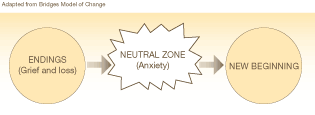Marketing Strategy: No Small Change
 Organizations Can Experience the Stress of Change When Implementing New Branding or Marketing Strategies
Organizations Can Experience the Stress of Change When Implementing New Branding or Marketing Strategies
The dynamics of change are challenging for any organization. Whether reacting to change or initiating change, the ambiguity and fear of the unknown that go with change create anxiety. It’s made worse when leaders don’t acknowledge that the experience of change is as important to manage as the actual mechanics of doing business differently. The change doesn’t have to be a merger, down-sizing or process engineering to have significant impact. It can be as simple as creating a new marketing program.
In my work helping clients to explore, identify and implement new marketing strategies I’ve seen the effects of change in a variety of circumstances:
- Addressing declining revenue in a down market
- Implementing a new marketing plan during the transition of senior leadership
- Adopting a new brand strategy as the CEO made unannounced plans to leave
- Developing a new strategic direction when an artistic director and an executive director were fighting for control of an arts non-profit
The lessons that are emerging from these and other experiences reinforce a number of best practices of change management. Emotionally-intelligent and systems-oriented practices help carry organizations more successfully through change.
See the Whole System – A systems perspective is one that recognizes that our current situation is the result of the interaction of multiple elements. There are many lenses through which to see and define the elements of a system. One, the integral model, suggests that there are subjective and objective aspects of human systems. Objective elements are those that can be demonstrated and observed. Subjective elements are thoughts, beliefs and feelings. Many organizations seek to drive change by attending only to the objective elements. Increasingly however, they are finding that success comes from attending to the subjective ideas, beliefs, passions and perspectives taken by individuals and shared culturally. Attending to those subjective areas – the “soft†stuff – means taking care of the emotional side of change.
William Bridges is known for his simple but useful model that highlights the emotional challenges of change. Organizations beginning a change start with an Ending. From there they move into a Neutral Zone where there is an intentional effort to move to a new end goal. Arrival at that end goal constitutes a New Beginning.
For organizations or individuals who have had change forced upon them, the first phase, Endings, is a phase of grief and loss. Time must be spent at this stage of change to recognize what is ending, and notice what is not ending. For those who are initiating the change, there may be less unwanted loss, but something must be given up in order to move forward. As painful as this time can be, the next phase, the Neutral Zone, can be even more challenging. In the Neutral Zone, we enter the unknown, a time of new learning, where risks must be taken to find solutions that take the organization toward its goal.
Acknowledge and Mitigate Anxiety — Organizations facing the unknown experience anxiety. The members in these organizations act out their anxiety in a variety of ways. Finger-pointing, blame-shifting, detachment, passive aggression, aggression, and scapegoating are among the behaviors that show up in the Neutral Zone. Trust, or lack of trust, can be a significant factor in change. Many are suspicious of who is behind the change and who will benefit the most. A lack of clear leadership will bring out aggression as individuals seek to impose a sense of order. Perhaps most important to notice is a tendency to personalize the anxiety of change and make friction or problems experienced in the change process a particular individual’s fault.
A variety of techniques can be used to address these behaviors if they arise during the implementation of a new marketing strategy or program. Perhaps the most important step to mitigate anxiety is openly acknowledging it and providing safe places for that anxiety to be expressed.
Leadership Sets the Tone – How is the top leader (or leaders) in the change reacting? Are they anxious? Are they risk-averse? Do they love learning new things and taking on new challenges? If the leader is anxious, the organization will be anxious. If the leader is not clear, his or her direct reports will be unclear. They will believe he or she has a plan and just isn’t telling them what it is. If the leader feels comfortable taking risks and making mistakes, he or she will make that okay for everyone else. That’s important because transformational and adaptive change means stepping into the unknown. Mistakes will be made. That’s how we learn the new way.
So, leaders in change must be aware of their own receptivity to change. Those that are anxious should find outside resources for support and not expect emotional reassurance from their employees. Those leaders who thrive in change need to be sensitive to those who are less comfortable and not label them as “the resistance.â€Â  Frequent communication about the change, clarifying where the organization is in the change process, and providing hope for a positive outcome are some of the greatest gifts leaders can give in a transition.
A more detailed unpacking of the Bridges model will provide additional insights for organizations going through change. John Kotter’s model for leading change in organizations also provides a series of action steps leaders can use to address the points above as they plan and manage the change.
Tags: business, integral theory, marketing, non-profits, Strategic planning, Strategy, systems, systems thinking

September 11th, 2009 at 11:16 am
strategic change management…
Great post. My approach to strategic change management says the quality of the first five percent determines what happens in the rest of the process. This same principle applies to many situations….
September 11th, 2009 at 1:26 pm
Agreed! Thanks for posting.